
Taman Botani Negara Shah Alam (Bukit Cerakah)
March 15, 2013
Taman Botani Negara Shah Alam (TBNSA) is an area of forests combined with plantations/botanical gardens that lies towards the north of Shah Alam city. The place also goes by the name of Bukit Cahaya Sri Alam, while the forest reserve itself is named Bukit Cerakah Forest Reserve. Previously, the park was named Taman Pertanian Malaysia (it’s confusing, I know). I will still refer to this place as Bukit Cerakah, after the name of the forest reserve, originally.
Previously covering several thousand hectares (up until quite recently), much of the low lying forest have already been converted into housing areas and now only a small remnant of the original rainforest remain, mainly centered on some hills, while the lowlands are home to the botanic gardens, with many plots featuring various types of agricultural crops and trees grown alongside the rainforest trees. The entire area now totals around 800 hectares.
I have frequented this place for nearly 25 years to date, right back from the days when the botanic gardens were very new, in the early 1990s. Many things have changed since; but sad to say, not for the better. Originally, the forest was much larger and “wilder”, but excessive development has resulted in localized extinctions of certain species of animals. Back then, a few individuals of tapir and panther were known to reside in the forest, and you could hear Argus pheasant calls during the daytime. Today, Bukit Cerakah is a forest island under siege.
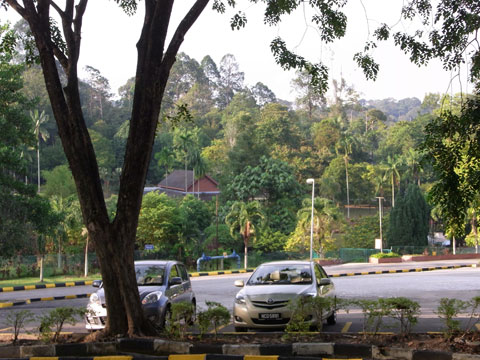
The carpark at the entrance of the park.
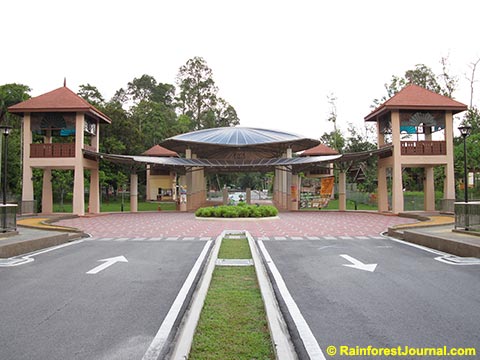
The new entrance into the park.
The view from a lookout tower in the TBNSA, or Taman Pertanian, showing one of the manicured gardens.

One of the lakes formed after the lowland forest was cleared for houses.
The clearance began during 2003 when a large portion of the Bukit Cerakah forest was parceled out to developers, logged, and totally cleared. The issue came to a head only in 2005 when aerial photos were splashed on the front pages of newspapers, but it was too late by then. The surrounding hilly forest areas where no houses were meant to be built, were also logged.
In terms of forest quality, I still consider Bukit Cerakah to be one of the best remaining (miniscule) patches of forest in the Klang Valley, due to portions of it possibly being “primary/virgin”. The low hills such as Bukit Sapu Tangan (Handkerchief Hill) and nearby ridges still harbor some stands of good sized Seraya trees, some over a meter in diameter. I am not sure if the VJR portion of the forest reserve is still remaining or not today, but this entire forest used to stretch all the way to Kota Damansara and FRIM, in the past.
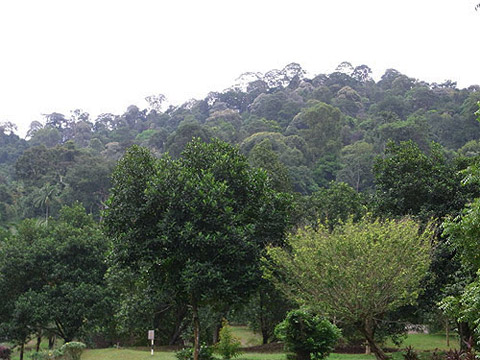
Some areas in TBNSA are likely to be in “primary” condition. They still provide a safe haven for small wildlife.

The signboard overlooking the “mystery tunnel” in TBNSA, near the Sungai Air Kuning dam.
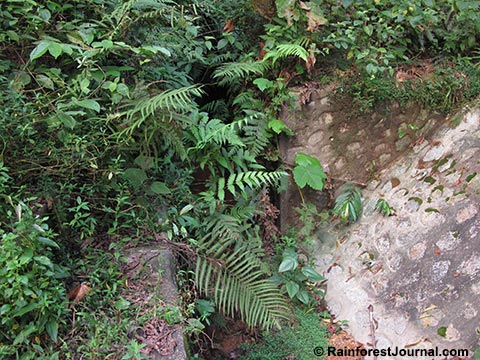
The “mystery tunnel” at Bukit Cerakah. This tunnel is most likely just an old aqueduct to channel water out from the Sungai Air Kuning dam, back then in the 1930s.
A serious problem?
However, it may be apparent to any regular visitor to Bukit Cerakah who keeps his/her eyes open, that many of the original forest trees have since died or toppled down, and there is no question this dieback is quite alarming and is NOT natural. In a natural state, a tropical forest is supposed to maintain equilibrium between growth/life and mortality, but here, mortality seems to be unusually high, certainly in the past few years. Trees here are dying faster than can be replaced, for reasons yet unknown. There used to be canopy walk here that is long gone, possibly due to the deaths of the supporting trees. In a future post, I will elaborate more on this negative phenomenon.
The forest and attractions
Bukit Cerakah is still considered a relic patch of coastal lowland Red Meranti-Keruing forest, and possibly one of the few intact patches on the entire West Coast of Peninsular Malaysia (featuring this specific sub-type). Within Selangor, it is likely the only significant area of flat lowland rainforest remaining (below 100m asl). Here, you get a glimpse of how the Klang Valley used to be like – many years ago. As for wildlife, the visitor can still expect to spot a variety of common lowland forest birds, insects, and small mammals like langurs, macaques, squirrels, and monitor lizards.

A typical scene along a road inside TBNSA. Great for bicycling.

The Four Season House, which has a special controlled climate within. Temperate plants are grown here for exhibit.
Inside the Four Season House, a mock temperate environment has been constructed, complete with artificial lighting and a wallpaper background. This pic is taken during the “late summer” or “early autumn” period.
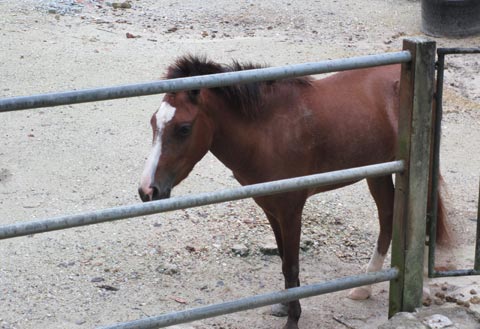
One of the ponies in the Animal Park/mini zoo. There are hardly any animals there at the time of this writing, save for some birds, and the ponies. There used to be porcupines, ostriches, deer, and seladang.
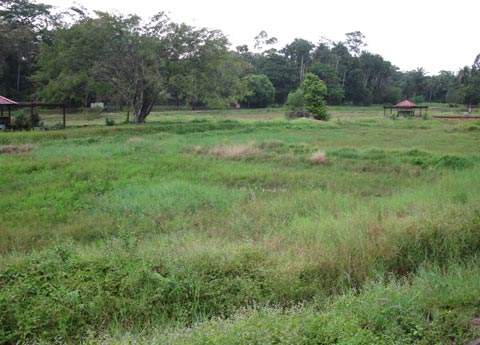
Paddy fields, or rather what remains after no maintenance for a long time (early 2015). Weeds have overgrown and snuffed out most of the paddy.
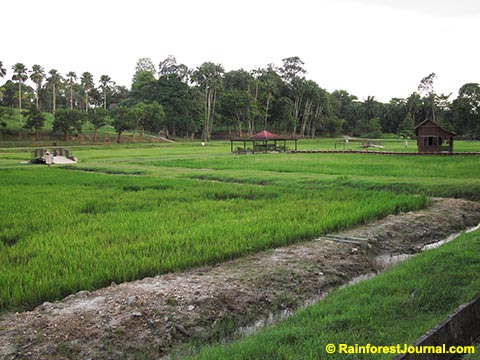
As of the end of 2015, the paddy fields have been replanted and looks like they are now being maintained.
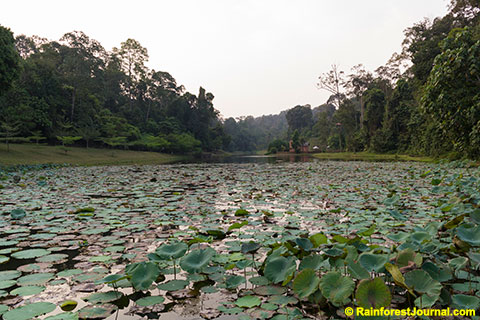
A lake covered in water lilies. TBNSA is much better than the KL Lake Gardens, if you ask me. It retains the original rainforest vegetation of Malaysia while combining it with tasteful development. The facilities could be improved upon and upgraded though.
The assortment of arboretums, plantations, ponds, lakes, a mini zoo, and a temperate “Four Season House”, all of which are interlinked by a network of tarred roads, still continue to draw in visitors daily; the main attractions seem to be bicycle riding, paintball, and outdoor activities (like flying fox) offered by a local outfit called Skytrex. The mini zoo used to house a pair of Seladang (Bos gaurus) in an enclosure, but they were not present anymore during my latest visit.

A juvenile reticulated python spotted in TBNSA. Be careful where you trod!
There are two old dams in the forest, namely the Sungai Baru and Sungai Air Kuning dams, which used to supply water to certain parts of Klang up till the 1950s, although long disused by now. Instead, both dams now provide opportunities for the avid angler. There is also a 3 km trail linking the dams, although I am not sure if the trail is already overgrown. Additionally, there is a mysterious old tunnel in the vicinity of the Sungai Air Kuning dam, which has been sealed up already, and is believed to be built before or during the Second World War. The tunnel is said to be infested with snakes.
If you are into nature, hiking up Bukit Sapu Tangan (Handkerchief Hill) can be a rewarding experience in spite of the steep climb. The hill stands 200-plus meters above sea level, in an otherwise undulating landscape, and offers nice panoramic views out over Shah Alam, the Klang Valley, and even across the Straits of Malacca, from an old lookout tower at its summit that is in need of restoration.
The destruction of the Bukit Cerakah forest can be seen from the top of Bukit Sapu Tangan (during the construction of the housing areas). The surrounding hills inside the park boundaries were not spared from logging either.
But a more beautiful sight for me anyway, is the view of the tree crowns of the tropical forest on the lower slopes below. It used to be that you could observe many large, beautiful Seraya (Shorea curtisii) trees in the forest canopy below, but unfortunately, many of them have already died since I first stepped foot on that tower 17 years ago. It is still a nice view as long as you don’t look in the north-western direction, what with all the wholesale clearance and logging from that side.
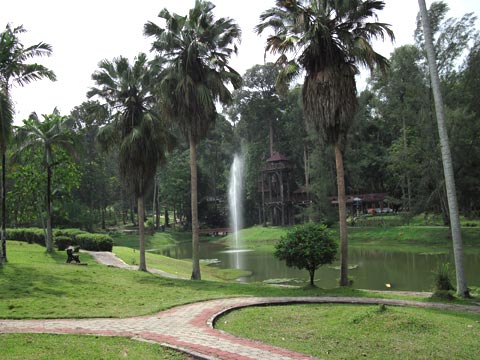
A good place to exercise, that’s for sure. There is a lookout tower, lakes, and an extensive paved road system. Spot the lookout tower next to the lake.
Accommodation is limited and many of the facilities are already defunct and dilapidated due to lack of maintenance (despite growing numbers of visitors, according to the official website). But all that can be forgiven IF you are just visiting for the “semi-wild nature experience”. It is one of those few places where you can still experience an authentic rainforest experience which is just a stone’s throw away from the hustle and bustle of the city.
For further information log on website :
http://www.rainforestjournal.com/taman-botani-negara-shah-alam-bukit-cerakah/


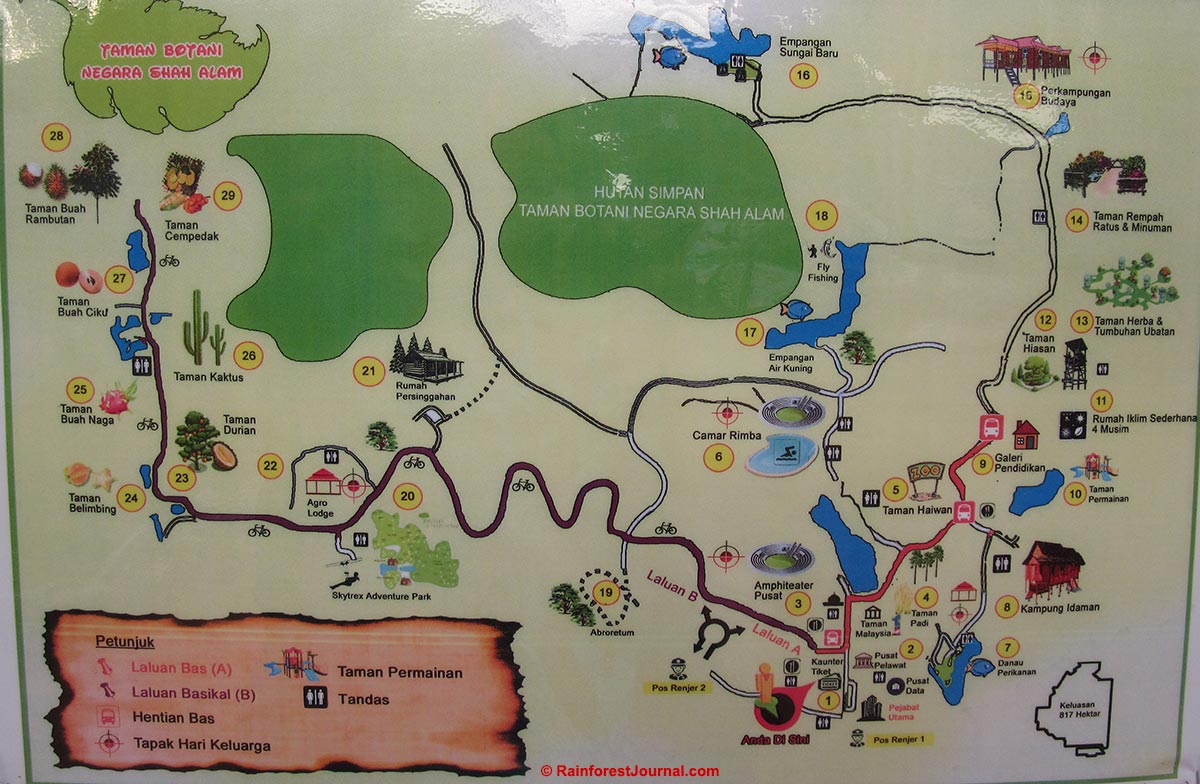











No comments:
Post a Comment